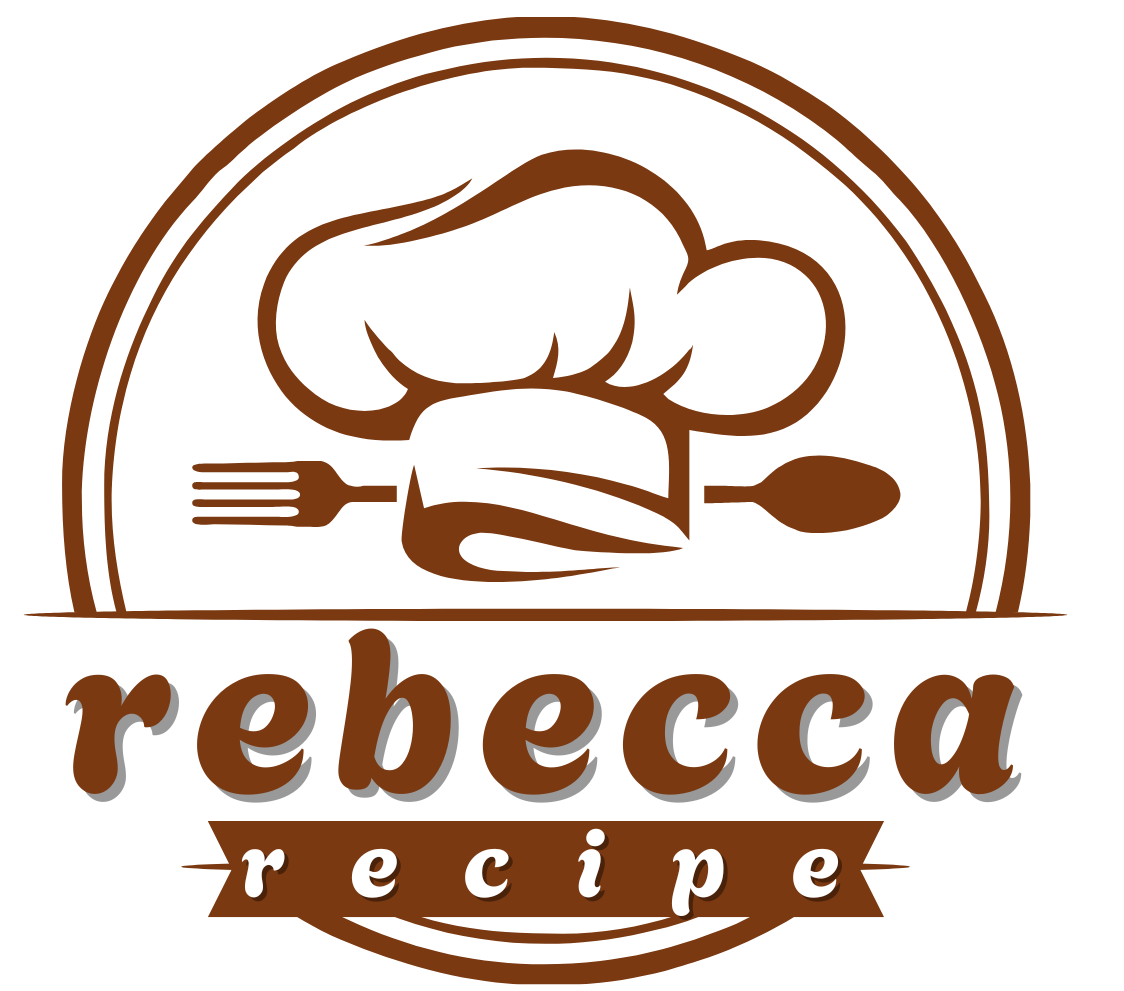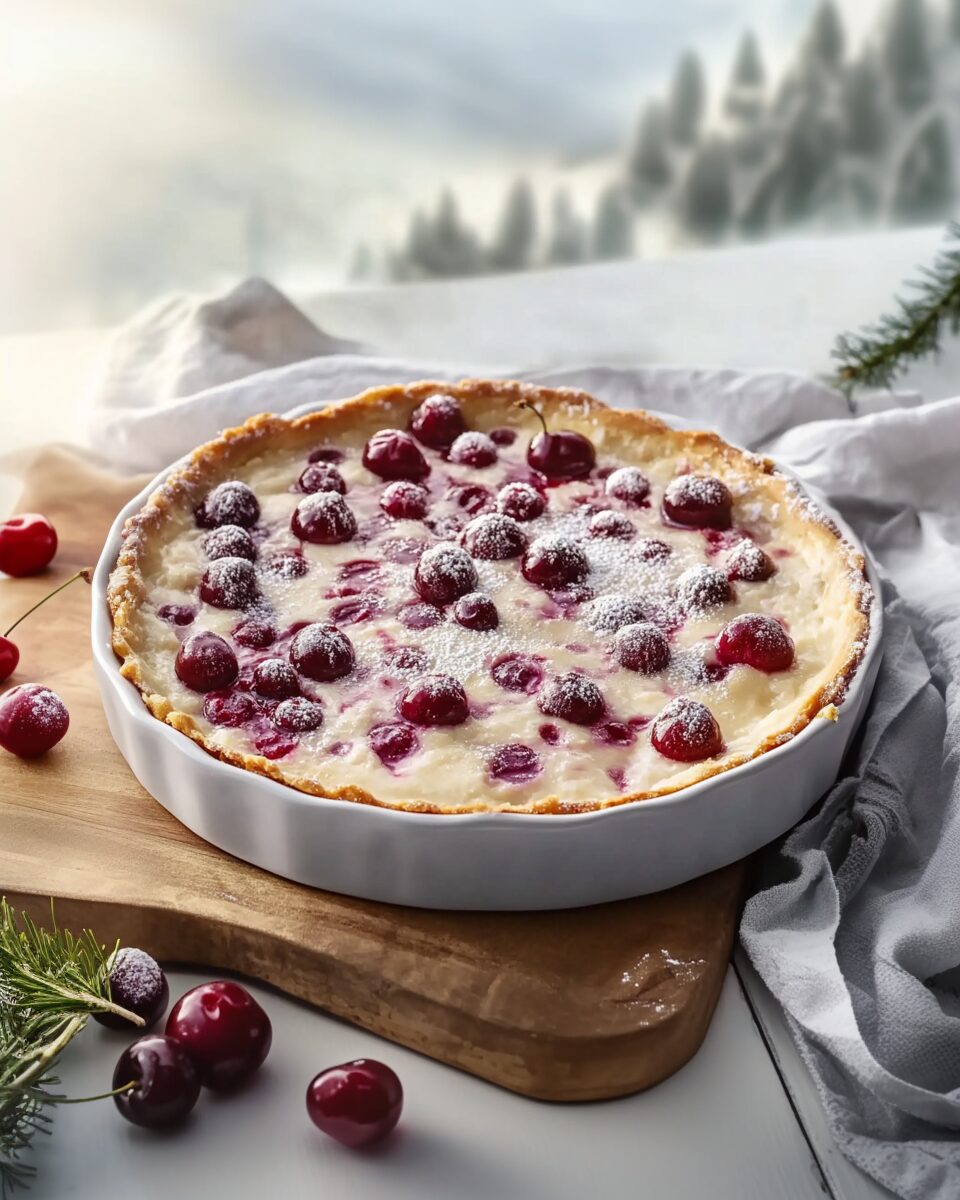Cherry Clafoutis is a classic French dessert that combines the sweetness of fresh cherries with a rich, custard-like batter. This dish, originating from the Limousin region of France, is easy to make and full of flavor, offering a delightful contrast between the soft, juicy cherries and the light, airy custard. Traditionally, Clafoutis is made with unpitted cherries, but for convenience and ease, pitted cherries are commonly used today. Perfect for a summer dessert or any time you’re craving something fruity and sweet, Cherry Clafoutis is a simple yet elegant dish that will impress your guests or provide a comforting treat for yourself.
Full Recipe:
Ingredients
- 1 tablespoon unsalted butter
- 1 pound fresh cherries, pitted
- 1/2 cup granulated sugar
- 1/2 cup all-purpose flour
- 1 cup whole milk
- 3 large eggs
- 1 teaspoon vanilla extract
- 1/2 teaspoon almond extract
- Pinch of salt
- Powdered sugar, for dusting (optional)
Directions
- Prepare the Baking Dish: Preheat your oven to 375°F (190°C). Place the butter in a 9-inch round or square baking dish and put it in the oven to melt. Once melted, remove the dish and swirl to coat the bottom and sides with butter.
- Arrange the Cherries: Spread the pitted cherries evenly over the bottom of the buttered baking dish.
- Prepare the Batter: In a blender, combine the sugar, flour, milk, eggs, vanilla extract, almond extract, and a pinch of salt. Blend until the mixture is smooth and slightly frothy.
- Assemble the Clafoutis: Pour the batter over the cherries in the baking dish, ensuring the cherries are submerged.
- Bake: Place the baking dish in the preheated oven and bake for 45-50 minutes, or until the clafoutis is puffed and golden brown. A knife inserted into the center should come out clean.
- Serve: Allow the clafoutis to cool for a few minutes before slicing. Dust with powdered sugar if desired. Serve warm or at room temperature.
Nutritional Facts
Per serving (based on 8 servings):
- Calories: 313 kcal
- Total Fat: 8g
- Saturated Fat: 3g
- Cholesterol: 152mg
- Sodium: 262mg
- Potassium: 311mg
- Total Carbohydrates: 54g
- Dietary Fiber: 3g
- Sugars: 41g
- Protein: 8g
The History and Origins of Clafoutis
The history of Clafoutis dates back to the 19th century, originating in the Limousin region of central France. The name “Clafoutis” is derived from the Occitan word “clafir,” meaning “to fill” or “to stuff,” which is fitting because the dish is traditionally made by filling a baking dish with fresh cherries, followed by a poured batter that turns into a cake-like custard during baking. While Clafoutis can be made with a variety of fruits, the cherry version is the most iconic, representing the essence of this French classic.
In its earliest forms, Clafoutis was a rustic, homey dessert meant to be made with ingredients readily available in rural households. Back in the day, it was common for the cherries to remain unpitted, as the time-consuming task of pitting each cherry wasn’t always practical. This tradition is still honored in some regions, although many modern recipes opt for pitted cherries for convenience and to make the dish easier to eat.
Over the years, Clafoutis has evolved and spread beyond France, gaining popularity worldwide for its simplicity, versatility, and rich flavor. Whether served as a breakfast treat, a light dessert, or even as part of a brunch spread, this dish has found its way into many kitchens, offering a taste of French culture to people around the globe.
The Versatility of Clafoutis
While the traditional version of Clafoutis is made with cherries, the dish’s versatility allows for a wide range of fruit substitutions. Depending on the season, different fruits such as apricots, plums, or raspberries can be used in place of cherries, making the dish adaptable to various tastes and available produce. This versatility not only allows the recipe to be made year-round but also offers opportunities to experiment with different flavor combinations.
Moreover, Clafoutis can be customized with flavorings such as almond extract, citrus zest, or vanilla, all of which complement the fruit and custard base. Some variations even include a touch of liqueur, such as Grand Marnier or Chambord, to enhance the dessert’s depth of flavor.
One of the reasons Clafoutis is so beloved is because of how easy it is to make. The batter is simple to prepare, requiring only a few basic ingredients, including eggs, milk, flour, sugar, and a pinch of salt. This minimal ingredient list makes Clafoutis not only delicious but also accessible, allowing both novice and experienced bakers to prepare it without much effort. The dish is forgiving and offers room for creativity, making it a perfect recipe for those looking to experiment in the kitchen while still achieving an impressive final result.
The Texture and Flavor Profile of Cherry Clafoutis
The charm of Cherry Clafoutis lies in its texture, which is somewhere between a custard, a cake, and a soufflé. When baked, the batter puffs up slightly around the cherries, creating a rich, custardy base with a light, cake-like consistency. The cherries themselves become tender as they bake, their natural juices infusing the batter with their sweetness, adding a fresh burst of flavor in every bite.
The flavor profile of Cherry Clafoutis is a perfect balance of sweetness and subtle richness. The cherries provide a sweet, tart contrast to the smooth, custardy batter, while the almond and vanilla extracts enhance the natural flavors of the fruit. The dish’s simplicity ensures that the cherries are the star of the show, with the light batter serving as a perfect backdrop.
Additionally, Cherry Clafoutis offers a wonderful contrast in textures. The outer edges of the dish tend to crisp up slightly, creating a delicate, golden crust, while the center remains soft and custardy. The cherries themselves soften as they cook, releasing their juices and becoming almost jam-like in texture, which contrasts nicely with the smoothness of the batter.
Nutritional Value and Health Benefits
While Cherry Clafoutis is certainly a treat, it also offers some nutritional benefits thanks to its main ingredient: cherries. Cherries are rich in antioxidants, particularly anthocyanins, which are known for their anti-inflammatory and heart-protective properties. They are also a good source of vitamins such as vitamin C, which boosts immunity, and vitamin A, which supports eye health. Cherries are also high in potassium, a mineral essential for maintaining healthy blood pressure.
The batter of the Clafoutis, made with eggs, milk, and flour, provides protein and calcium, further enhancing the nutritional profile of the dish. However, as with most desserts, Clafoutis is best enjoyed in moderation, as it contains sugar and butter, which contribute to its calorie count. For those looking to make the dessert a bit healthier, there are options for substitutions, such as using almond flour instead of all-purpose flour or reducing the amount of sugar.
Overall, Cherry Clafoutis can be considered a relatively healthy dessert compared to other options, particularly because it incorporates fresh fruit and can be made with wholesome ingredients. When enjoyed in moderation, it offers a satisfying, nutrient-packed dessert option that provides both flavor and health benefits.
How to Serve Cherry Clafoutis
Cherry Clafoutis can be served in a variety of ways, depending on the occasion. For casual family meals or gatherings, it’s often served at room temperature, making it easy to prepare in advance. Some prefer to serve it warm, straight from the oven, allowing the custard to remain soft and slightly gooey, while others enjoy it cooled down for a firmer, more cake-like texture.
The dish can be served with a simple dusting of powdered sugar for added sweetness or paired with a dollop of whipped cream or a scoop of vanilla ice cream for a more indulgent treat. For a more sophisticated presentation, Cherry Clafoutis can be garnished with fresh mint leaves or a sprinkle of toasted almonds to add an extra layer of flavor and texture.
For a brunch or breakfast setting, Cherry Clafoutis can be served alongside other light dishes, such as yogurt, fresh fruit, or croissants, making it a delightful and slightly unexpected addition to the spread. Its balance of sweetness and richness also makes it suitable for serving at dinner parties, where it can be a perfect ending to a multi-course meal.
Cherry Clafoutis in Modern Times
Today, Cherry Clafoutis has become a favorite in kitchens all over the world, not just in France. It has made its mark on food blogs, cookbooks, and Instagram feeds, with home bakers and professional chefs alike creating their own takes on the dish. While some may stick to tradition, using only cherries and the classic batter, others experiment with different fruits, such as blueberries, strawberries, or even peaches, adding their personal touch to the recipe.
In the age of food sustainability and local eating, Cherry Clafoutis also benefits from being a recipe that can easily highlight seasonal, local produce. In many parts of the world, cherries are only available in late spring and early summer, making this dessert a celebration of the season. It’s also a dish that invites creativity with toppings, flavorings, and substitutions, making it as versatile as it is delicious.
Conclusion
Cherry Clafoutis is more than just a dessert; it’s a celebration of fresh, seasonal produce and a dish that embodies the simplicity and elegance of French cooking. Its tender, custard-like texture and rich cherry flavor make it a treat that is beloved around the world. Whether you’re a seasoned baker or a novice in the kitchen, this dish is easy to make and guaranteed to impress.






